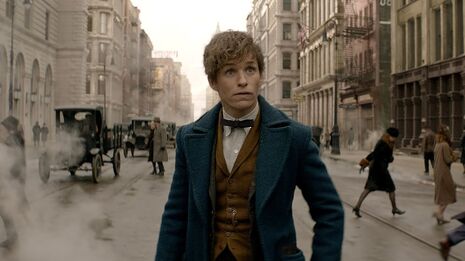Film: Fantastic Beasts and Where to Find Them
Rosie Best is wowed by the Harry Potter prequel, with a great performance and a riveting plot

It’s been over five years (!) since the final instalment of the Harry Potter film series was released and, as a devoted fan of both the movies and books, I approached Fantastic Beasts and Where to Find Them with caution.
I did not read any reviews, watch the clips or even listen to the soundtrack; I wanted to go in completely blind. And in my mind there were two distinct possibilities: this film would either ruin a franchise in which myself and many others are heavily emotionally invested, or give it a new lease of life – allowing me an excuse to indulge my inner (although not well-concealed) Potterhead for the next few years.
Set in New York, 1926, Fantastic Beasts begins with a flurry of frantic Daily Prophet headlines which submerge the viewer in the context of the film: Gellert Grindelwald, the infamous dark wizard, is at large and suspected of engineering the strange attacks which are destroying New York and prompting some suspicious no-majs (muggles) to begin a ‘Second Salem’.
Meanwhile, Newt Scamander (Eddie Redmayne) arrives with a broken suitcase full of magical creatures, including a kleptomaniac niffler, a rhinoceros-like erumpent and a half-bird, half-dragon occamy, which produces valuable silver eggs.
The escaped niffler leads to no-maj Jacob (Dan Fogler) mistaking Newt’s case for his own during a chaotic incident in one of the city’s banks, and the two are apprehended by demoted auror Tina Goldstein (Katherine Waterston). The trio embark on a quest to recapture Newt’s beasts, but when one of his creatures is mistakenly accused of causing the death of a muggle senator, the film takes a dark turn and we see the lengths to which the magical president is willing to go in order to keep her society hidden.
I would be doing this film an injustice to say it lived up to my hopes: it exceeded them in virtually every way. Fantastic Beasts reminded me of why I was initially captivated by the Harry Potter universe and it was surely Rowling’s screenplay which achieved the same effect again. Despite having been based on a simplistic spin-off, written in aid of comic relief and less than 150 pages, the film was reminiscent of the experience of reading one of Rowling’s full-length novels – complete with carefully-structured internal logic and shocking plot twists.
While the final reveal of the film (no spoilers!) and the insights into the American wizarding community are, alone, enough to draw in a viewer, one gets the feeling that this is only the beginning of an intricate and complex plot. At the end of the film, Newt Scamander watches passively as a small piece of a supposedly destroyed Obscurus floats away, and there are several ambiguous allusions to a mysterious Lestrange girl – an old friend of Newt’s. These are surely loose ends which will be tied up, or perhaps further entangled, in the next four films. Clearly there’s a lot more to look forward to.
In terms of casting, Eddie Redmayne was a perfect Newt. His body language and lack of eye contact with other actors suggested an intelligent but awkward character, eccentric and misunderstood in his enthusiasm for the creatures which others view as threatening. Indeed, we are told that Newt was expelled from Hogwarts for endangering a fellow student’s life with a magical creature and Redmayne had clearly considered the background of his character in his portrayal of him. Ezra Miller also gave an outstanding performance as the isolated and abused son of ‘Second-Salemer’ Mary Lou Barebone (Samantha Morton), capturing perfectly the character’s desperation for approval and freedom in his interactions with Colin Farrell, who played an auror – Percival Graves.
What is, perhaps, most moving about Fantastic Beasts and Where to Find Them is its theme of power. While the CGI and the Potter references are all impressive and very satisfying for a fan, the issues Rowling touches upon in her screenplay are incredibly contemporary and, in the film, the notion of abused power and the oppression of minorities seems particularly poignant.
While it is dangerous to start comparing this film with the Potter series, Fantastic Beasts is certainly a film more than worthy of following it. I look forward to the next four films with great anticipation
 News / Cambridge academics stand out in King’s 2026 Honours List2 January 2026
News / Cambridge academics stand out in King’s 2026 Honours List2 January 2026 Interviews / You don’t need to peak at Cambridge, says Robin Harding31 December 2025
Interviews / You don’t need to peak at Cambridge, says Robin Harding31 December 2025 Comment / What happened to men at Cambridge?31 December 2025
Comment / What happened to men at Cambridge?31 December 2025 News / Varsity’s biggest stories of 202531 December 2025
News / Varsity’s biggest stories of 202531 December 2025 Features / “It’s a momentary expression of rage”: reforming democracy from Cambridge4 January 2026
Features / “It’s a momentary expression of rage”: reforming democracy from Cambridge4 January 2026









